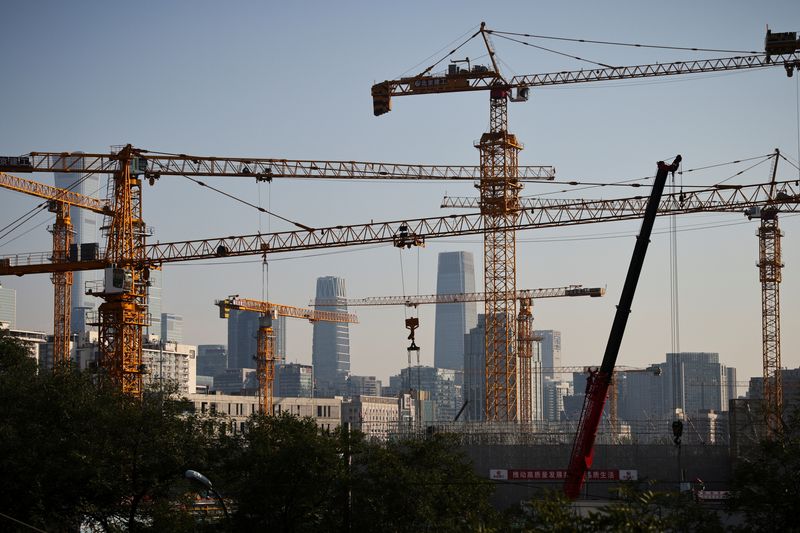Ukraine war, higher rates to limit growth in developing Asia – ADB
2022.07.21 03:14

FILE PHOTO: A view shows cranes in front of the skyline of the Central Business District (CBD) in Beijing, China, October 18, 2021. REUTERS/Thomas Peter
By Karen Lema
MANILA (Reuters) – The Asian Development Bank (ADB) on Thursday slashed its growth forecasts for developing Asia for this year and next, reflecting the economic fallout from Russia’s war in Ukraine and aggressive tightening by global central banks to tame inflation.
Also contributing to its weaker growth forecasts was a sharper-than-expected deceleration in China prompted by its lingering COVID-19 lockdowns, the ADB said in a supplement to its Asian Development Outlook report.
Downgrading its 2022 forecast for a third time, the ADB said it now expects the bloc’s combined economy, which includes China and India, to expand 4.6%, slower than its 5.2% projection in April.
“Risks to developing Asia’s economic outlook remain elevated and mainly associated with external factors,” the ADB said, citing a substantial slowdown in global growth, the U.S. Federal Reserve’s aggressive tightening, and surge in commodity prices.
For 2023, the region is forecast to grow 5.2%, down slightly from its earlier forecast of 5.3%, the ADB said.
“From within the region, downside risks could arise from the potentially lingering effects on supply chains from (China’s) latest round of lockdowns and the country’s growth slowdown, which could hinder developing Asia’s growth momentum,” the multilateral lending organisation said.
China’s economy will likely expand 4.0% this year, the ADB said, a drop of 1 percentage point from its April forecast, but will recover lost ground in 2023 with growth seen at 4.8%.
The growth outlook for the sub-regions was mixed, with Southeast Asia, Central Asia and the Pacific expected to grow faster than initially projected, while South Asia was forecast to expand more slowly due to the economic crisis in Sri Lanka and high inflation in India.
The ADB chopped its growth forecast for South Asia to 6.5% from 7.0% this year and to 7.1% from 7.4% in 2023.
With soaring inflation gripping much of the world, the ADB upgraded its inflation forecasts for this year and next to 4.2% and 3.5 % from 3.7% and 3.1%, respectively.
“Inflation pressures in the region, are however, less than elsewhere in the world,” the ADB said.
GDP GROWTH
2020 2021 2022 2022 2022 2022 2023 2023
SEPT DEC APR JULY APR JULY
Central Asia -2.0 5.6 4.2 4.4 3.6 3.8 4.0 4.1
East Asia 1.8 5.1 5.0 4.7 3.8 4.5 4.5
7.7
China 2.2 8.1 5.5 5.3 5.0 4.0 4.8 4.8
South Asia -5.2 7.0 7.0 7.0 6.5 7.4 7.1
8.1
India -6.6 7.5 7.5 7.5 7.2 8.0 7.8
8.7
SEast Asia -3.2 2.9 5.0 5.1 4.9 5.0 5.2 5.2
Indonesia -2.1 3.7 4.8 5.0 5.0 5.2 5.2 5.3
Malaysia -5.6 3.1 6.1 5.9 6.0 5.8 5.4 5.1
Myanmar 3.2 -18.4 n/a n/a -0.3 n/a 2.6 n/a
Philippines -9.6 5.5 6.0 6.0 6.5 6.3 6.3
5.7
Singapore -4.1 7.6 4.1 4.1 4.3 3.9 3.2 3.2
Thailand -6.2 3.9 4.0 3.0 2.9 4.5 4.2
1.5
Vietnam 2.9 2.6 6.5 6.5 6.5 6.5 6.7 6.7
The Pacific -6.0 -0.6 4.8 4.7 3.9 4.7 5.4 5.4
Developing -0.8 6.9 5.4 5.3 5.2 4.6 5.3 5.2
Asia
INFLATION
2020 2021 2022 2022 2022 2022 2023 2023
SEPT DEC APR JULY APR JULY
Central Asia 7.7 8.9 6.7 7.3 8.8 11.3 7.1 8.1
East Asia 2.2 1.1 2.2 2.0 2.4 2.3 2.0 2.1
China 2.5 0.9 2.3 2.1 2.3 2.1 2.0 2.0
South Asia 6.5 5.1 5.3 6.5 7.8 5.5 6.6
5.8
India 6.2 4.8 4.8 5.8 6.7 5.0 5.8
5.5
SEast Asia 1.5 2.0 2.4 2.5 3.7 4.7 3.1 3.4
Indonesia 2.0 1.6 2.7 2.7 3.6 4.0 3.0 3.3
Malaysia -1.1 2.5 2.3 2.3 3.0 2.7 2.5 2.5
Myanmar 5.7 3.6 n/a n/a 8.0 n/a 8.5 n/a
Philippines 2.4 3.9 3.5 3.7 4.2 4.9 3.5 4.3
Singapore -0.2 2.3 1.4 1.4 3.0 4.7 2.3 2.3
Thailand -0.8 1.2 1.0 1.4 3.3 6.3 2.2 2.7
Vietnam 3.2 1.8 3.5 3.8 3.8 3.8 4.0 4.0
The Pacific 2.9 3.1 4.1 4.1 5.9 5.9 4.7 4.7
Developing 3.2 2.5 2.7 2.7 3.7 4.2 3.1 3.5
Asia








